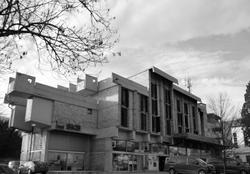Edvard Ravnikar, Hotel Creina in Kranj, 1968/70, photo by Raimondo Mercadante, January 2019
Uncategorized / Piranesi 48/49
History, ideologies, conflicts: a multilayered approach to Slovenian architecture in the late twentieth century (1970–1990)
History, ideologies, conflicts: a multilayered approach to Slovenian architecture in the late twentieth century (1970–1990)
This article is a brief presentation of a PhD thesis “Architecture as architecture. Criticism, theory, projects and works from Edvard Ravnikar to the “ab” group. Slovenia 1970–1990.” by Raimondo Mercadante (PhD in “Architecture. History and Project” conferred by the Politecnico di Torino in 2022). Advisors: Prof. Alessandro De Magistris, advisor (Politecnico di Milano), Àkos Moravánszky, co-advisor (eth Zürich), Michele Caja, co-advisor (Politecnico di Milano)., which will be the subject of a monograph to be published in 2024 by Leuven University Press.
This research was started with the aim of filling a gap in the literature. The events that took place in Slovenian architecture between the 1970s and 1980s, with the ideological crisis of the school of Edvard Ravnikar, the so-called “School of Ljubljana”, and the subsequent emergence of theories related to postmodernism, have so far not been deeply investigated, even in the Slovenian literature.
In many respects, this doctoral research has been a challenging task: in addition to linguistic issues, with the need to learn Slovenian and Serbo-Croatian and overcome a great amount of scepticism, I had to understand the system of Yugoslav architecture, focusing on the particularities of the Slovenian case and identifying the sources useful to grasp its complexity.
In historiography, however, a look from the outside has often been illuminating: one can just think of Anthony Blunt’s studies on French architecture, or on the Roman or Sicilian Baroque, where unprecedented links with European architecture were revealed, or the importance of Manfredo Tafuri’s research on German theory and criticism from the early decades of the twentieth century, when long-neglected authors were first translated at the Istituto di analisi critica e storica in Venice.
This is even more valid for the history of Slovenian architecture, where different actors have contributed their own reading of events, often pursuing personal primacy, and where a strong localism divides Ljubljana and central Slovenia from the eastern region headed by Maribor, whose architecture has frequently been underestimated.
In his acceptance speech given at the award ceremony for the Plečnik Prize for 1974, Marco Pozzetto, the historian who first made international readers acquainted with Max Fabiani and Jože Plečnik, observed how Slovenian architecture was surprising for the originality of its historical development, despite pressures from the West and the Balkans: the “miracle” of Slovenian architectural culture was the ability of a national community so small in terms of geography and demographics to express its own voice.[1]
[1] Marco Pozzetto, “Nagrade Plečnikova”, Arhitektov bilten št. 23, 1975, p. 19

























